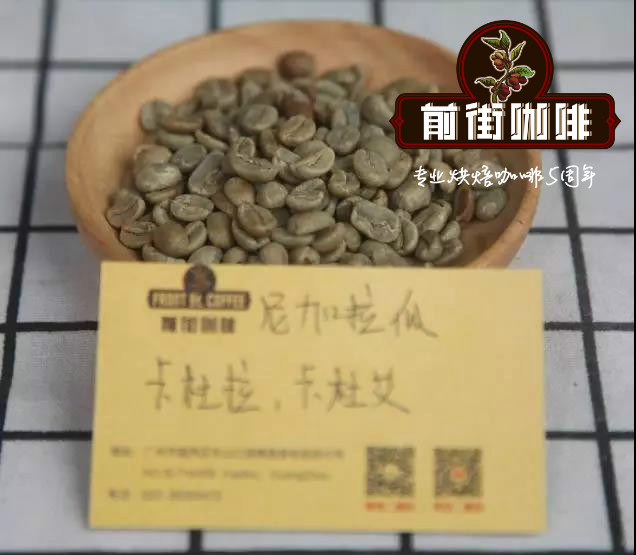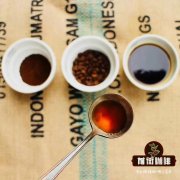There is no shit coffee in Nicaragua! Introduction to the producing area of Nicaraguan Coffee

Professional coffee knowledge exchange more coffee bean information please follow the coffee workshop (Wechat official account cafe_style)
Overview
When it comes to Nicaragua, the most famous is its waterfall, while Nicaraguan coffee seems to have been forgotten in the world these years, and Nicaraguan coffee is rarely seen. In fact, the growing conditions in Nicaragua are not inferior to those in Central American countries, and the coffee produced by small farmers is characterized by a balanced taste. What is amazing is that the coffee produced by small farmers is as clean, bright and sour as Costa Rican coffee in shallow roast. deep roasting gives off the sweet, mellow taste of Colombian coffee. In this issue, the editor of the World Coffee Tour will introduce Nicaragua to you.
Geography and climate
Nicaragua is located in the central part of Central America, bounded by Honduras in the north, Costa Rica in the south, the Caribbean Sea in the east and the Pacific Ocean in the west, with a total area of 130400 square kilometers, making it the largest country in Central America. The central north of Nicaragua is a highland; the east is a coastal plain with many jungle swamps and low-lying terrain; the west is a coastal lowland with many volcanoes and lakes in the east.
The Nicaragua plain has a high temperature and rainy climate, and belongs to a tropical oceanic climate; in the western coastal lowlands, the precipitation is obviously less than that in the east, and there are dry and wet seasons, so it belongs to the savanna climate; the average annual temperature in the central highlands is 18 ℃, and the annual precipitation is 1500 ℃ 2500 mm, with the rainy season from May to December.
Major producing areas and harvest season
Nicaragua is mainly divided into four major producing areas, namely, Bosnia and Herzegovina Sub-region (Segovias), Matagalpa / Sinodega region (Matagalpa/Jinotega), Borgo region (Boaco) and Pacific Coast region (Pacific).
A more famous brief introduction to the producing areas:
Xenotega Jinotega
The name of the district and its capital both derive from the Nahuatl language "xinotencatl", which means "city for the elderly". The region's economy has long been dependent on coffee and is a major producing area in Nicaragua.
Altitude: 1100-1700
Harvest time: December to March of the following year
Main varieties: Kaddura, bourbon
Matagalpa Matagalpa
This is another area named after the capital city, and there is a museum with coffee as its theme, which comes from manors and cooperatives.
Altitude: 1100-1400 m
Harvest time: December to February of the following year
Main varieties: Kaddura, bourbon
New Segovia Nueva Segovias
This area, located on the northern border of Nicaragua, has begun to establish the reputation of the best coffee in the country in recent years, and has also achieved great success in the Nicaragua Excellence Cup competition.
Altitude: 1100-1650 m
Harvest time: December to March of the following year
Main varieties: Kaddura, Kaduai, bourbon
Coffee flavor characteristics
The smell of Nepalese coffee is slightly different from that of China, America and China, and its aroma is more stuffy.
The flavor is mostly complex, soft, with creamy, chocolate, fruit and nutty flavors, pure and pleasant acidity.
Grading
Nicaraguan coffee is graded according to planting altitude
Strictly High Grown (Ultra High altitude) (SHG): 1500mm 2000m
High Grown (High altitude) (HG): 1300 to 1500m
Medium Grown (medium altitude) (MG): 1000-1300m
Low Grown (low altitude) (LG): 500 '1000m
A brief History of Coffee Development
From 1840 to 1940, it was the "coffee boom" in Nicaragua, and coffee began to become the main export crop in Nicaragua. With the strong promotion of the government, foreign companies could easily invest or acquire land, which led to the birth of large estates. After that, the autocratic ruler Somoza established the coffee cooperative (1936-1979), but it was soon overthrown by the Sanding National Liberation Front (Sandinistas). When Nepal entered communist rule in 1979, the coffee trade became very difficult. The CIA began to support the rebels (Contras) in an attempt to overturn the New deal. In order to gain greater benefits, they did not hesitate to attack coffee workers' vehicles, destroy processing plants and create unrest, which dealt another big blow to Nepalese coffee. Nevertheless, coffee is still the most important export cash crop in Nepal. After the 20th century, there was a sharp drop in coffee prices (1999-2003), hurricanes and millennium droughts. Today, there are about 40,000 coffee farmers in Nepal. Due to the shortage of funds for chemical fertilizers, most coffee trees are grown organically. Coffee farmers begin to focus on quality and production and marketing resumes, which means coffee can be traced back to a single manor. or a co-operative formed by producers. ) the coffee industry in Nepal is showing signs of a gradual revival.
Elephant beans and derived varieties
[Malaggippe Maragogipe]
Nicaraguan coffee is the largest of all coffee beans, among which the giant Maragogipe beans produced in Matagalpa are the most distinctive. This kind of giant bean particle is larger than the general coffee bean, also known as elephant bean, is a natural mutant of Arabica. According to the growth of the soil, the taste of Malaggippe will be different, while the barren soil will weaken the taste of coffee. This is why it is often called "not very tasty" coffee. In the coffee world, Malaggippe is a less common breed because of its low yield, so it is also popular with coffee fans.
[Malakadura Maracaturra]
This variety comes from the mixture of elephant beans and Kaddura, which has both the full shape of the former and the sweet flavor of the latter, and is common in Nicaragua. Like beans, Malakadura coffee beans have a large body. Unfortunately, this variety is prone to leaf rust and therefore requires a high degree of care, with a tropical fruit flavor and bright acidity.
[Pacamara Pacamara]
Pacamara is a hybrid bred artificially in El Salvador in 1958, whose parents are Pacas and elephant beans. The most important feature of this variety is that it is sour and lively, sometimes biscuit, sometimes fruity, thick and greasy.
Baking and cooking
Nicaragua's general beans can be baked in accordance with the conventional baking method, using medium and light baking will often appear similar to almonds, walnuts and other nutty flavor, sweetness is also good, the acidity is clean and refreshing, the aftertaste will be similar to plum aroma.
The elephant bean and its derived varieties have a very large bean shape, coupled with high altitude, high soybean density, and slow heat absorption in the baking process. In order to let the heat fully permeate, it is necessary to lengthen the dehydration process, and in order to highlight the pleasant acidity of high-altitude coffee, you can choose to increase firepower after turning yellow, which helps to enhance the Mena reaction to create a multi-level flavor. And reduce water loss to make the explosion go smoothly.
Recommended hand punching parameters
Beans used this time: Nicaragua [Fairview Manor] Malakadura washing
Degree of grinding: BG bean grinder 5R (64% of Chinese standard No. 20 screen pass rate)
V60 filter cup, 16g powder, water temperature 90g 91 ℃, ratio of water to powder 1 15max 16 (can be adjusted according to concentration preference), total cooking time: 2 minutes and 15 seconds.
First steam with 30 grams of water, let the coffee powder exhaust, absorb water, steaming time about 30 seconds, when observed that the noodles began to appear "matte", that is, the time of water injection extraction.
The first stage of water injection is extracted evenly around the size of a coin in the center, and the water level is cut off to about 160g, so that the water level is lowered by 1cm 2, and the second stage is injected slowly to 260g. Be careful not to rush to the edge of the filter paper.
Flavor features: this coffee has a deep aroma, with aromas similar to dried papaya and dried lemon, with almond, caramel and cocoa flavors in the middle, with a long finish of dried licorice plums.
Related recommendation: is hand-made coffee really good? Why does coffee smell better than it tastes?
Important Notice :
前街咖啡 FrontStreet Coffee has moved to new addredd:
FrontStreet Coffee Address: 315,Donghua East Road,GuangZhou
Tel:020 38364473
- Prev

How to mix coffee with milk? what kind of milk is better for coffee?
Professional coffee knowledge exchange more coffee bean information Please pay attention to the secret of milk in the coffee workshop (Wechat official account cafe_style) in the coffee shop's drink menu, milk and espresso are the soul elements that make up most drinks. The process of making a cup of milk coffee is by no means easy, and it takes a lot of patience to witness the barista inject milk into the
- Next

Jamaica Coffee Blue Mountain how is authentic Jamaica Blue Mountain Coffee introduction
Professional coffee knowledge exchange more coffee bean information please follow the coffee workshop (Wechat official account cafe_style) Jamaica Coffee Blue Mountain shipments are very small, in 1717 King Louis XV ordered the cultivation of coffee in Jamaica, in the mid-twenties, the Governor of Jamaica Nicholas. Sir Nicholas Lawes imported it from Martinique.
Related
- How did the Salvadoran coffee industry develop in Central America?
- What exactly does the golden cup extraction of coffee mean?
- The Origin of Coffee flower
- [2023 Starbucks World Earth Day] there are more meaningful things besides free Starbucks coffee!
- What kind of coffee is there in Spain? 9 Flavors of Spanish Coffee
- Aromatic African coffee| Kenya's coffee culture and historical production area
- Liberica Coffee Bean knowledge: the characteristics of Liberian Coffee beans of the three original species of Coffee beans
- The origin and formula of Spanish latte introduces the taste characteristics of Bombon coffee in Valencia, Spain.
- How to adjust the solution of over-extracted coffee
- What is the tasting period of coffee beans? What is the period of coffee and beans? How should coffee wake up and raise beans?

